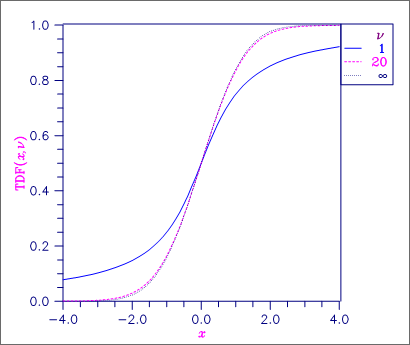TDF
This function evaluates the Student’s t cumulative distribution function.
Function Return Value
TDF — Function value, the probability that a Student’s t random variable takes a value less than or equal to the input T. (Output)
Required Arguments
T — Argument for which the Student’s t distribution function is to be evaluated. (Input)
DF — Degrees of freedom. (Input)
DF must be greater than or equal to 1.0.
DF must be greater than or equal to 1.0.
Optional Arguments
COMPLEMENT — Logical. If .TRUE., the complement of the Student’s t cumulative distribution function is evaluated. If .FALSE., the Student’s t cumulative distribution function is evaluated. (Input)
See the Description section for further details on the use of COMPLEMENT.
Default: COMPLEMENT = .FALSE..
See the Description section for further details on the use of COMPLEMENT.
Default: COMPLEMENT = .FALSE..
FORTRAN 90 Interface
Generic: TDF (T, DF [, …])
Specific: The specific interface names are S_TDF and D_TDF.
FORTRAN 77 Interface
Single: TDF (T, DF)
Double: The double precision name is DTDF.
Description
Function TDF evaluates the cumulative distribution function of a Student’s t random variable with DF degrees of freedom. If the square of T is greater than or equal to DF, the relationship of a t to an F random variable (and subsequently, to a beta random variable) is exploited, and routine BETDF is used. Otherwise, the method described by Hill (1970) is used. Let ν = DF. If ν is not an integer, if ν is greater than 19, or if ν is greater than 200, a Cornish‑Fisher expansion is used to evaluate the distribution function. If ν is less than 20 and ABS(T) is less than 2.0, a trigonometric series (see Abramowitz and Stegun 1964, equations 26.7.3 and 26.7.4, with some rearrangement) is used. For the remaining cases, a series given by Hill (1970) that converges well for large values of T is used.
If COMPLEMENT = .TRUE., the value of TDF at the point x is 1 ‑ p, where 1 ‑ p is the probability that the random variable takes a value greater than x. In those situations where the desired end result is 1– p, the user can achieve greater accuracy in the right tail region by using the result returned by TDF with the optional argument COMPLEMENT set to .TRUE. rather than by using 1 ‑ p where p is the result returned by TDF with COMPLEMENT set to .FALSE..

Figure 29, Student’s t Distribution Function
Example
In this example, we find the probability that a t random variable with 6 degrees of freedom is greater in absolute value than 2.447. We use the fact that t is symmetric about 0.
USE TDF_INT
USE UMACH_INT
IMPLICIT NONE
INTEGER NOUT
REAL DF, P, T
!
CALL UMACH (2, NOUT)
T = 2.447
DF = 6.0
P = 2.0*TDF(-T,DF)
WRITE (NOUT,99999) P
99999 FORMAT (' The probability that a t(6) variate is greater ', &
'than 2.447 in', /, ' absolute value is ', F6.4)
END
Output
The probability that a t(6) variate is greater than 2.447 in absolute value is 0.0500
Published date: 03/19/2020
Last modified date: 03/19/2020





